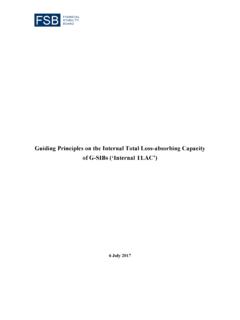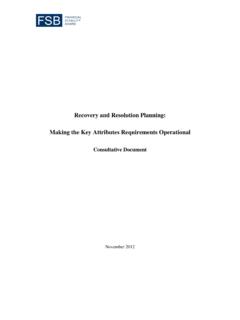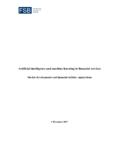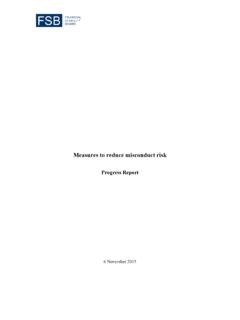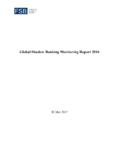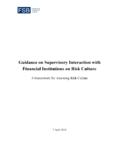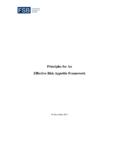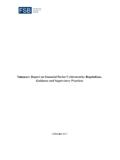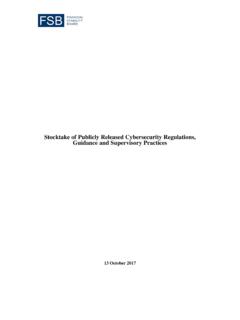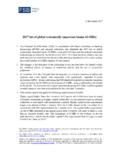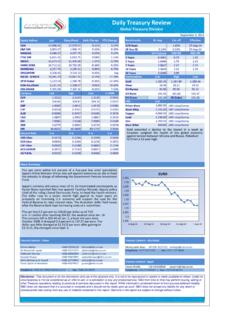Transcription of Reforming major interest rate benchmarks
1 Reforming major interest rate benchmarks Progress report on implementation of July 2014 FSB recommendations 10 October 2017 ii The Financial Stability Board (FSB) is established to coordinate at the international level the work of national financial authorities and international standard-setting bodies in order to develop and promote the implementation of effective regulatory, supervisory and other financial sector policies.
2 Its mandate is set out in the FSB Charter, which governs the policymaking and related activities of the FSB. These activities, including any decisions reached in their context, shall not be binding or give rise to any legal rights or obligations under the FSB s Articles of Association. Contacting the Financial Stability Board Sign up for e-mail alerts: Follow the FSB on Twitter: @FinStbBoard E-mail the FSB at: Copyright 2017 Financial Stability Board. Please refer to: iii Contents Page Executive Summary.
3 1 1. Introduction .. 4 The 2014 recommendations .. 4 Contractual robustness .. 4 Next steps .. 5 2. Developments in IBOR+ benchmarks .. 6 Overview .. 6 Developments at international level .. 6 Developments in major IBORs .. 6 EURIBOR .. 6 LIBOR .. 8 TIBOR .. 10 Developments in other markets .. 11 Australia .. 11 Brazil .. 13 Canada .. 13 Hong Kong .. 14 Mexico .. 14 Singapore .. 15 South Africa .. 15 Switzerland .. 16 3. Developments in RFR benchmarks .. 18 Overview .. 18 US dollar.
4 19 Euro .. 20 Japanese yen .. 23 Sterling .. 24 Swiss franc .. 26 Australian dollar .. 26 Brazilian real .. 27 Canadian dollar .. 27 Hong Kong dollar .. 27 Mexican peso .. 28 iv Singapore dollar .. 28 South African rand .. 28 4. Contractual robustness to risks of discontinuance of widely-used interest rate benchmarks .. 30 Appendix A List of Abbreviations and Acronyms .. 32 Appendix B Members of the FSB OSSG benchmark Group .. 34 Appendix C Letter from Co-chairs of Official Sector Steering Group to International Swaps and Derivatives Association.
5 36 1 Executive Summary This document reports on progress made in implementing the recommendations of the 2014 FSB report Reforming major interest Rate benchmarks (the 2014 Report).1 In the 2014 Report, the FSB set out a series of recommendations for strengthening existing benchmarks for key interbank offered rates (IBORs) in the unsecured lending markets, and for promoting the development and adoption of alternative nearly risk-free reference rates (RFRs) where appropriate.
6 The FSB and member authorities through the FSB Official Sector Steering Group (OSSG) are working to implement and monitor these recommendations together with benchmark administrators. Progress is reported since the last progress report in July 2016 (the 2016 Progress Report),2 with relevant additional background. Strengthening of IBORs Since the 2016 Progress Report, the IBOR administrators have continued to take important steps towards implementing the recommendations of the FSB. The administrators for the three major interest reference rates Euro Interbank Offered Rate (EURIBOR), London Interbank Offered Rate (LIBOR) and Tokyo Interbank Offered Rate (TIBOR) have commenced a variety of measures to test and improve the robustness of their respective IBOR methodologies.
7 Administrators, in consultation with their stakeholders, have taken steps to adjust the methodologies employed to calculate the benchmark rate. The European Money Markets Institute (EMMI) began developing a hybrid model for the EURIBOR that will combine transactions, related market data and expert judgement. The ICE benchmarks Administration Ltd (IBA) administrator of LIBOR, and Japanese Bankers Association (JBA) TIBOR Administration (JBATA), administrator of TIBOR, have also made adjustments to their methodologies to account for a lack of substantial transaction data.
8 OSSG member authorities, benchmark administrators and market participants from other jurisdictions, including Australia, Hong Kong, Mexico, Singapore and South Africa, have continued to take steps to strengthen the existing interbank rates in their jurisdictions as well. However, in the case of some IBORs such as LIBOR and EURIBOR, underlying reference transactions in some currency tenor combinations are scarce, and submissions therefore necessarily remain based on a confluence of factors including transactions, and expert judgement.
9 Regulators have also taken various steps to develop new or amend current regulatory and supervisory standards governing benchmarks . For example, the UK Financial Conduct Authority (FCA) launched a consultation in June 2017 regarding their compulsion powers for mandatory contributions to benchmarks , and the European Securities and Markets Authority (ESMA) published a convergence document on this topic in June 2017. Notwithstanding these steps, it remains challenging to ensure the integrity and robustness of benchmarks based on expert judgement submissions, and it is uncertain whether the banks 1 Available at 2 FSB (2016), Reforming major interest Rate benchmarks .
10 Progress report on implementation of July 2014 FSB recommendations, available at 2 asked to submit such judgements can be relied upon to continue to do so over the medium or longer term. Those concepts were the basis of the speech on the future of LIBOR3 made by Andrew Bailey, FCA CEO, in July where he said that after 2021 the benchmark would no longer be sustained through the mechanism of the FCA persuading or obliging panel banks to stay. In other words the survival of LIBOR could not and would not be guaranteed.
